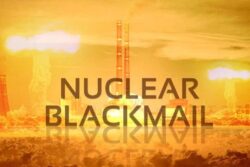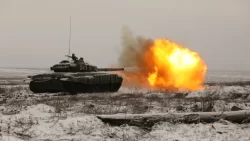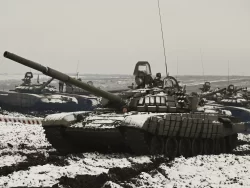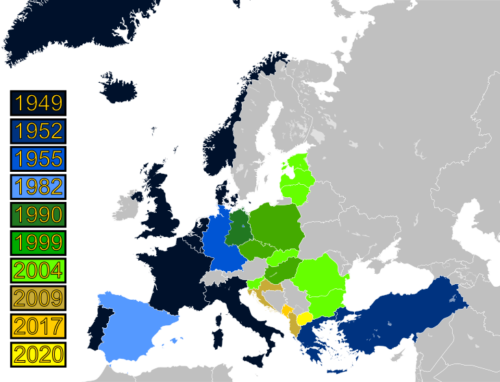 by Carl Conetta, 30 May 2023.
by Carl Conetta, 30 May 2023.
Some say that turning to diplomacy in the face of nuclear threats will prompt a rash of nuclear proliferation and coercion. They’re wrong.
 Carl Conetta, 02 May 2023. see article ⇒ HTML or PDF
Carl Conetta, 02 May 2023. see article ⇒ HTML or PDF
The war has been a disaster for Ukraine, but also a calamity for the world. This brief article provides a concise overview of the war’s profound global effects, beginning with the combatants’ cost in lives and treasure. Beyond this it assesses the war’s impact on global trade and economy; energy and food price inflation and their effects on poverty, hunger, and mortality; the redirection of humanitarian and official development assistance; the total sum of aid to the Ukrainian war effort, and the estimated cost of postwar reconstruction and recovery. Also examined is the war’s effect on global defense spending. The article also provides copious citations to support further inquiry.
The probability of Russian nuclear use related to the Ukraine war is rising – but why? Neither Washington nor Brussels fully apprehend the risk.
 by Carl Conetta, 02 Feb 2023 – Full report: HTML or PDF Summary: HTML or PDF
by Carl Conetta, 02 Feb 2023 – Full report: HTML or PDF Summary: HTML or PDF
This article tracks and assesses the evolution of Russian nuclear threats in the Ukraine crisis, the related interplay between Moscow and Washington, the factors driving Russian thinking on nuclear use, the nuclear options available to Russia, and why US-NATO leaders and hawkish observers dismiss these options as impracticable. We conclude that the probability of Russian nuclear use, although conditionally modest, is rising as Ukraine’s armed forces push forward toward Crimea and the Russian border while also increasing their retaliatory attacks on recognized Russian territory. On its present trajectory, the crisis will soon run a risk of nuclear conflict greater than that experienced during the 1962 Cuban Missile Crisis.
➪ see full post: HTML
by Charles Knight, 17 October 2022
The Ukraine War presents a more dangerous nuclear risk than the Cuban Missile Crisis and demands more careful rationality and restraint by Russia and the US. Can we  depend on that rationality and restraint? Probably not.
depend on that rationality and restraint? Probably not.
However, there are some things that the US and NATO can do to reduce the probability that Moscow will opt to use nuclear weaponry. This article lists those steps.
The article also explains why any remaining “stable mutual deterrence” between the US and Russia is presently extremely fragile. It concludes:
The US/NATO war effort in Ukraine must remain deliberately limited. Beyond that, we must resist the usual war fevers (beset with visions of victory over evil) that take nations toward total war.
The short answer is “no” – but there is more to the issue than that. A closer look at the road to war illuminates paths to a negotiated end
by Carl Conetta, 10 June 2022

With no end in sight, the Russia-Ukraine conflict is an unfolding catastrophe for Ukraine, the region, and the world. Besides increasing battlefield death and destruction, the war and how it is being fought promise global economic recession, severe food crisis, a surging flow of refugees, pandemic revival, and a transnational flood of illicit military weapons and munitions.
This essay looks at the policies that shaped the contention leading to war, and that increased the likelihood of conflict. It looks at the effects of NATO expansion and military activism, the “color revolutions” in Ukraine, the disposition of Crimea, the rebellions in Ukraine’s east, the Minsk process, Putin’s revisionism, Russia’s security concerns, and how the USA and Europe responded to the intensifying friction between Moscow and Kyiv. Through closely examining the policies conditioning the conflict, this analysis aims to identify potential “exit ramps” for all involved.
⇒ see full post: HTML
by Carl Conetta, updated 02 April 2022
 How do the two sides in the Russia-Ukraine conflict compare in terms of personnel and equipment losses? These seemingly objective measures are subject to an intensive propaganda war. This brief analysis examines multiple sources of data to find that the combatants are actually not far apart in the percentage of equipment attrition they have suffered. And Russian personnel fatalities are likely in the range of 3,500 (April 2). Contrary to the messaging of the two sides, both would seem able to sustain combat for a considerable time longer. Unfortunately, as Russian forces have transitioned to a heavier, more firepower-dominant mode of warfare, Ukrainian civilians and civilian infrastructure are suffering more death and destruction. While this might argue for increased emphasis on war containment and diplomatic efforts, the most evocative messaging on the western side emphasizes Russian miscalculation and fumbling, Ukraine’s adept resistance, and the promise of war termination via increased investment in the war.
How do the two sides in the Russia-Ukraine conflict compare in terms of personnel and equipment losses? These seemingly objective measures are subject to an intensive propaganda war. This brief analysis examines multiple sources of data to find that the combatants are actually not far apart in the percentage of equipment attrition they have suffered. And Russian personnel fatalities are likely in the range of 3,500 (April 2). Contrary to the messaging of the two sides, both would seem able to sustain combat for a considerable time longer. Unfortunately, as Russian forces have transitioned to a heavier, more firepower-dominant mode of warfare, Ukrainian civilians and civilian infrastructure are suffering more death and destruction. While this might argue for increased emphasis on war containment and diplomatic efforts, the most evocative messaging on the western side emphasizes Russian miscalculation and fumbling, Ukraine’s adept resistance, and the promise of war termination via increased investment in the war.
⇒ see full post: HTML
by Carl Conetta, 21 Feb 2022
 The battle within Ukraine and the USA-Russia contest over it has returned Europe to the darkest, most ominous period of the 1947-1989 Cold War. That this should happen with both the United States and Russia barreling grimly forward reflects a singular failure of diplomacy and common sense. There were two recent points in time when positive leadership might have turned us away from the path of disaster. Fortunately, one of these is not yet foreclosed. The short essay examines them both, asking how did we get here? It concludes with the question: Is it harder to live with autonomy for the Ukrainian rebel areas than it is to face regional war?
The battle within Ukraine and the USA-Russia contest over it has returned Europe to the darkest, most ominous period of the 1947-1989 Cold War. That this should happen with both the United States and Russia barreling grimly forward reflects a singular failure of diplomacy and common sense. There were two recent points in time when positive leadership might have turned us away from the path of disaster. Fortunately, one of these is not yet foreclosed. The short essay examines them both, asking how did we get here? It concludes with the question: Is it harder to live with autonomy for the Ukrainian rebel areas than it is to face regional war?
⇒ see full post: HTML
Carl Conetta, 14 Feb 2022
 Moscow will act when and if it declares that the West has escalated contention rather than responding positively to its entreaties – principally those regarding NATO expansion and implementation of the Minsk II agreement. Recent US/NATO troop deployments and weapon transfers to Ukraine may already count as relevant escalation. Russian forces surrounding Ukraine stand at an exceptionally high level of readiness and significantly exceed the scale of previous deployments. A full-scale invasion aiming to seize the whole of Ukraine seems unlikely. Indeed, Russian action may involve no more than large-scale conveyance of weapons and munitions to the rebel areas, possibly along with an influx of “volunteers.” Several other options ranging between these two are discussed in the essay.
Moscow will act when and if it declares that the West has escalated contention rather than responding positively to its entreaties – principally those regarding NATO expansion and implementation of the Minsk II agreement. Recent US/NATO troop deployments and weapon transfers to Ukraine may already count as relevant escalation. Russian forces surrounding Ukraine stand at an exceptionally high level of readiness and significantly exceed the scale of previous deployments. A full-scale invasion aiming to seize the whole of Ukraine seems unlikely. Indeed, Russian action may involve no more than large-scale conveyance of weapons and munitions to the rebel areas, possibly along with an influx of “volunteers.” Several other options ranging between these two are discussed in the essay.
by Carl Conetta, 26 Jan 2022
 The basic elements of a solution to the Ukraine crisis are ready at hand – and have been since Feb 2015. These are the provisions of the Minsk II Protocol. This Reset Defense blog post reviews the impediments to Minsk II implementation and suggests a way forward. The key to progress is cooperation among the outside powers supporting the Ukraine contestants (i.e., Kyivv government and rebels). These benefactors must make their material support contingent on the near-term implementation of Minsk II. Another key element missing from the current agreement is the provision for a substantial peacekeeping and monitoring force to oversee the demilitarization of the area, temporarily control its external and internal borders, and secure an election.
The basic elements of a solution to the Ukraine crisis are ready at hand – and have been since Feb 2015. These are the provisions of the Minsk II Protocol. This Reset Defense blog post reviews the impediments to Minsk II implementation and suggests a way forward. The key to progress is cooperation among the outside powers supporting the Ukraine contestants (i.e., Kyivv government and rebels). These benefactors must make their material support contingent on the near-term implementation of Minsk II. Another key element missing from the current agreement is the provision for a substantial peacekeeping and monitoring force to oversee the demilitarization of the area, temporarily control its external and internal borders, and secure an election.
by Lutz Unterseher, PDA Guest Publication, August 2018. ➪ PDF
Secretary-General Gorbachev’s astounding and pivotal speech to the UN General Assembly in December of 1988 announced substantial reductions and defensive restructuring of Soviet conventional forces in Eastern Europe.
Lutz Unterseher, living at that time in Bonn, West Germany, was a leading developer of the concepts of the confidence-building restructuring of armed forces intended to reduce East-West military tensions and improve crisis stability. There is no doubt that some of these concepts were influential with Soviet officials in Gorbachev’s closest circles. This article is Lutz Unterseher’s recollection of some of his most consequential interactions with Soviet analysts and diplomats in the several years before Gorbachev’s announcement of the force reductions and restructuring.
by Charles Knight, Huffington Post, 03 February 2016 HTML
“A cold war framework for our relations with China, Russia, and any other powers that might eventually align with them will almost certainly result in the addition of $200 to 300 billion in annual U.S. security expenditures. It would also very significantly divert the energies of Americans from many social and environmental goals. The U.S. will end up deferring domestic investments needed to sustain its economic strength.”

➪ PDF Pr esentation by Charles Knight on a panel sponsored by the Economists for Peace and Security at the Allied Social Sciences Association conference in Boston, MA, 04 January 2015. Others on the panel included: James Carroll, Richard Kaufman, Robert Skidelsky, Allen Sinai, and Stephen Walt.
esentation by Charles Knight on a panel sponsored by the Economists for Peace and Security at the Allied Social Sciences Association conference in Boston, MA, 04 January 2015. Others on the panel included: James Carroll, Richard Kaufman, Robert Skidelsky, Allen Sinai, and Stephen Walt.

This report offers an alternative to “balancing” the arms in the former Yugoslavia by way of transfers and military aid. Instead, it illustrates the restructuring of the region’s militaries toward greater stability with “mutual defensive superiority.” This study was initiated at the request of Ambassador Jonathan Dean who serves on PDA’s Research Advisory Board.
by Carl Conetta and Lutz Unterseher. May 1994.
Newly published in ➪ PDF.
Originally, this primer was written and then published in spiral-bound book format for a series of seminars sponsored by the Study Group on Alternative Security Policy (SAS) and the Project on Defense Alternatives (PDA). These seminars were held in 1994 in several of the newly sovereign states of Europe: the Czech Republic, Hungary, and Belarus.
In 1994 no suitable seminar host was found in Ukraine. Although confidence-building defenses can not solve all of Ukraine’s strategic dilemmas during the present war with Russia, initial evidence strongly suggests that its military has made successful use of some of the principal aspects of a confidence-building defense.
The primer remains one of the most comprehensive presentations of the concepts of Confidence-Building Defense (C-BD), including details of their application to the structuring and operations of national armed forces. It totals 116 pages with 94 charts and tables.
Although some details of arms and tactics change over time, the fundamentals remain relevant to present-day international security, military planning, and the furthering of peaceful relations.
by Carl Conetta and Charles Knight, Institute for Defense and Disarmament Studies, May 1990.
The report takes a critical look at late-Cold War plans for defending Western Europe from the Warsaw Pact attack, finding these plans to be both unrealistic and destabilizing. It proceeds to clearly specify a robust alternative area-defense option and then considers standard objections to area-defense concepts.
“[L]ooking beyond the current bipolar orientation of central European armies, the adoption by nations in the region of spider-and-web defenses, reconfigured to provide all-around security, would help ensure the necessary military foundation for peaceful political, social, and economic development. “
by Carl Conetta and Charles Knight, Defense and Disarmament Alternatives, Institute for Defense & Disarmament Studies, 13 February 1990. ➪ PDF
For a summary of the contemporary European conventional arms control situation see Thomas K. Longstreth, “The Future of Conventional Arms Control in Europe,” FAS Public Interest Report Vol. 41 No. 2, February 1988 ➪ PDF
rapporteur, Carl Conetta. A workshop co-sponsored by the Institute for Defense and Disarmament Studies and the RAND Corporation featuring a presentation by Lutz Unterseher, a response by Barry Posen, and participant discussion, Washington, DC, 17 January 1989. ➪ PDF
In his presentation Unterseher warned that unless conventional arms reductions in Europe are combined with defensive reductions, they could actually undermine rather than improve stability by increasing both sides’ vulnerability to surprise attack. Posen agreed but judged that any significant shift toward a SAS-type alternative is not now feasible. Instead, a step-by-step process of bilateral reductions and restructuring might work.
by Carl Conetta, Conference Report, in Defense and Disarmament Alternatives, the newsletter of the Institute for Defense and Disarmament Studies (IDDS), January 1989.
 Report on the September 1988 conference, co-hosted by the Institute for World Economy and International Relations (IMEMO) and Institute for Defense and Disarmament Studies (IDDS), of Soviet and US arms control and military policy specialists. The report summarizes the exchange regarding problems and prospects for conventional force reductions in Europe.
Report on the September 1988 conference, co-hosted by the Institute for World Economy and International Relations (IMEMO) and Institute for Defense and Disarmament Studies (IDDS), of Soviet and US arms control and military policy specialists. The report summarizes the exchange regarding problems and prospects for conventional force reductions in Europe.
These meetings happened a little less than two months before President Gorbachev’s historic announcement at the UN in December of 1988 of substantial unilateral reductions and defensive restructuring of Soviet troops in eastern Europe – one of the most significant policy shifts in the process of ending the European Cold War. This international conference likely had more import than most.
by Charles Knight, 18 March 1988. PDF
In this previously unpublished paper from 1988, the author reviews various models for simulating war along the Central Front in Germany and their relevance for finding a stable conventional force balance in Europe (and elsewhere.) Force structures that tend to produce stable outcomes in battlefield simulations are likely to have more deterrent value in the real world.
“[C]omplex models [can] be very useful in distinguishing the conditions (i.e. force structures, tactics, and armaments) that produce chaotic, oscillating, or unstable outcomes from those that produce stable outcomes.
“The outcome of a conflict between balanced forces as currently structured is unknowable and unpredictable. This would seem to support the position that no stable conventional deterrent to war can be built, short of overwhelming superiority. If that was as far as our analysis went, we [might] end up giving support to flexible response doctrine with its fundamentally unstable nuclear deterrent component. Of course, the favored option is to model restructured conventional forces that can take us out of the chaotic conventional battlefield and give us stable outcomes.”